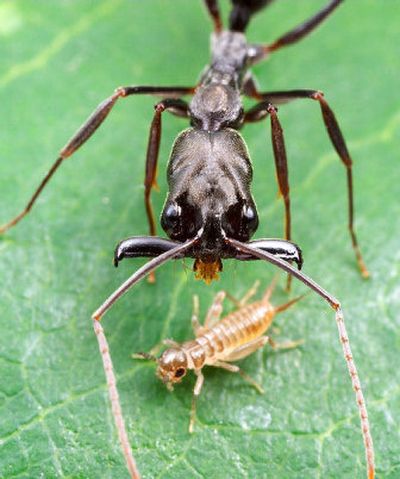Ant’s jaw snaps faster than humans can blink

WASHINGTON – A tiny ant has the fastest jaw in the animal kingdom – literally quicker than the blink of an eye.
The trap-jaw ant’s scientific name may be ponderous, Odontomachus bauri, but this hunter can clamp its mandibles shut at between 78 mph and 145 mph, according to a report in Monday’s online edition of Proceedings of the National Academy of Sciences.
That makes it faster than the mantis shrimp, former record holder for fastest strike, according to researchers led by Sheila Patek, assistant professor of integrative biology at the University of California, Berkeley.
Even better, it can snap those jaws shut with such force that it can propel itself backward out of danger.
The team used high-speed videos to record the strike of the ant and calculate its speed.
The average time for a strike was 0.13 milliseconds, some 2,300 times faster than the blink of an eye, they reported.
And the quick jaw movement, snapped against the ground, can provide retreat, resulting in the ant flipping itself into the air and potentially away from danger.
Seeing them do that was “one of the more hilarious moments in our lab,” Patek said in a telephone interview.
The ants don’t hurt themselves; they just sort of land, roll over and walk away, she said. And sometimes they’ll grab onto things on the way down.
As for their victims, these ants hunt small prey such as young crickets. Sometimes those fast-closing jaws make a catch, sometimes they don’t.
It’s fascinating that these ants have co-opted a feeding apparatus for this other use, escaping danger, said co-author Andrew V. Suarez, who teaches animal behavior at the University of Illinois at Urbana-Champaign.
The ants are about one-third of an inch long and can throw themselves as much as 3.2 inches upward and 15.6 inches sideways. According to Patek’s researchers, that’s roughly equivalent to a 5-foot-6-inch human jumping up 44 feet and sideways 132 feet.
So, how do they do that?
A pair of powerful muscles in the head hold the ant’s jaws open and they can be snapped shut by triggering a latch.
It’s sort of like triggering a crossbow, where the power is stored in the flexible bow and can be instantly released, said Patek.
Trap-jaw ants are found in Central and South America. Those used in the study came from Costa Rica.
What prompts such research?
Patek had published a paper reporting that the mantis shrimp had the fastest strike in the animal kingdom.
Suarez, an ant expert, saw it and thought his ants might be faster, but he didn’t have the equipment to measure their movement.
So he sent a box of ants to Patek, whose lab includes equipment that can film at thousands of frames per second. Normal video works at 24 frames per second.
Using such high-speed video, they were able to slow down the movement and measure its speed – the result, an animal faster than a speeding mantis shrimp.
Besides just being fascinating, Suarez said, he believes there may be real-world applications for this finding. The ant is able to store powerful forces and release them suddenly. From an engineering perspective this may be useful in robotics, he said in a telephone interview.
The research was funded by a grant from the Beckman Institute for Advanced Science and Technology at the University of Illinois at Urbana-Champaign.